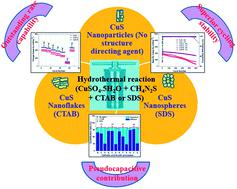当前位置:
X-MOL 学术
›
Sustain. Energy Fuels
›
论文详情
Our official English website, www.x-mol.net, welcomes your feedback! (Note: you will need to create a separate account there.)
Morphology oriented CuS nanostructures: superior K-ion storage using surface enhanced pseudocapacitive effects
Sustainable Energy & Fuels ( IF 5.6 ) Pub Date : 2020-04-28 , DOI: 10.1039/d0se00469c Chandrasekaran Nithya 1, 2, 3, 4 , Gowtham Thiyagaraj 5, 6, 7, 8
Sustainable Energy & Fuels ( IF 5.6 ) Pub Date : 2020-04-28 , DOI: 10.1039/d0se00469c Chandrasekaran Nithya 1, 2, 3, 4 , Gowtham Thiyagaraj 5, 6, 7, 8
Affiliation

|
In this work, CuS nanostructures are successfully synthesized by using two different structure directing agents, cetyl trimethyl ammonium bromide (CTAB) and sodium dodecyl sulphate (SDS). For comparison CuS nanostructures are also synthesized without a structure directing agent. The morphologically dependent electrochemical properties such as the capacity, cycling stability, rate capability and capacitive controlled kinetics are comparatively investigated for potassium-ion batteries. The structure directing agents play a vital role in determining the surface area and electrochemical performance of the CuS nanostructures. The CTAB based CuS nanostructure shows a flake like morphology (length 100–150 nm and diameter 5–10 nm) whereas the SDS based CuS exhibits nanospheres with a particle size of 5–15 nm. The capacity, cycling stability and capacitive contribution are higher for the SDS assisted synthesis of the CuS based electrodes as compared to the CTAB assisted CuS and CuS without any agent. At a low current density of 0.1 A g−1, the SDS based CuS electrode exhibits an excellent reversible capacity of 470 mA h g−1. It also exhibits a stable reversible capacity of 451 mA h g−1 with a capacity retention of 73% after 500 cycles at a current density of 0.5 A g−1 (500 mA g−1). The excellent electrochemical performance of the SDS based CuS is attributed to its spherical morphology with a smaller particle size that exhibits a large surface area and the resulting surface dominated pseudocapacitive mechanism enhances the K+ ion storage. The comparative study of these CuS nanostructures can afford significant insights into the design of high performance potassium-ion batteries using hierarchical nanostructures with distinct morphologies.
中文翻译:

形态学导向的CuS纳米结构:使用表面增强的伪电容效应实现出色的K离子存储
在这项工作中,通过使用两种不同的结构导向剂,十六烷基三甲基溴化铵(CTAB)和十二烷基硫酸钠(SDS)成功地合成了CuS纳米结构。为了比较,还合成了没有结构导向剂的CuS纳米结构。对钾离子电池的形态相关的电化学性质,如容量,循环稳定性,倍率能力和电容控制动力学进行了比较研究。结构导向剂在确定CuS纳米结构的表面积和电化学性能中起着至关重要的作用。基于CTAB的CuS纳米结构显示出片状形态(长度100–150 nm,直径5–10 nm),而基于SDS的CuS则显示出粒径为5–15 nm的纳米球。容量,与CTAB辅助的CuS和不含任何试剂的CuS相比,SDS辅助的CuS基电极的SDS辅助合成的循环稳定性和电容性贡献更高。在0.1 A g的低电流密度下-1,基于SDS的CuS电极具有470 mA hg -1的出色可逆容量。在电流密度为0.5 A g -1(500 mA g -1)的情况下,经过500次循环后,它还表现出451 mA hg -1的稳定可逆容量,保持73%的容量。SDS基CuS的出色电化学性能归因于其球形形态,较小的粒径和较大的表面积,所得到的表面主导的拟电容机制增强了K +离子存储。这些CuS纳米结构的比较研究可以为使用具有不同形态的分层纳米结构的高性能钾离子电池的设计提供重要的见识。
更新日期:2020-06-30
中文翻译:

形态学导向的CuS纳米结构:使用表面增强的伪电容效应实现出色的K离子存储
在这项工作中,通过使用两种不同的结构导向剂,十六烷基三甲基溴化铵(CTAB)和十二烷基硫酸钠(SDS)成功地合成了CuS纳米结构。为了比较,还合成了没有结构导向剂的CuS纳米结构。对钾离子电池的形态相关的电化学性质,如容量,循环稳定性,倍率能力和电容控制动力学进行了比较研究。结构导向剂在确定CuS纳米结构的表面积和电化学性能中起着至关重要的作用。基于CTAB的CuS纳米结构显示出片状形态(长度100–150 nm,直径5–10 nm),而基于SDS的CuS则显示出粒径为5–15 nm的纳米球。容量,与CTAB辅助的CuS和不含任何试剂的CuS相比,SDS辅助的CuS基电极的SDS辅助合成的循环稳定性和电容性贡献更高。在0.1 A g的低电流密度下-1,基于SDS的CuS电极具有470 mA hg -1的出色可逆容量。在电流密度为0.5 A g -1(500 mA g -1)的情况下,经过500次循环后,它还表现出451 mA hg -1的稳定可逆容量,保持73%的容量。SDS基CuS的出色电化学性能归因于其球形形态,较小的粒径和较大的表面积,所得到的表面主导的拟电容机制增强了K +离子存储。这些CuS纳米结构的比较研究可以为使用具有不同形态的分层纳米结构的高性能钾离子电池的设计提供重要的见识。


























 京公网安备 11010802027423号
京公网安备 11010802027423号